初中九年级英语动词(二) 课件(25张PPT,无音频)
文档属性
| 名称 | 初中九年级英语动词(二) 课件(25张PPT,无音频) |  | |
| 格式 | zip | ||
| 文件大小 | 1.9MB | ||
| 资源类型 | 教案 | ||
| 版本资源 | 人教新目标(Go for it)版 | ||
| 科目 | 英语 | ||
| 更新时间 | 2020-05-26 11:07:04 | ||
图片预览

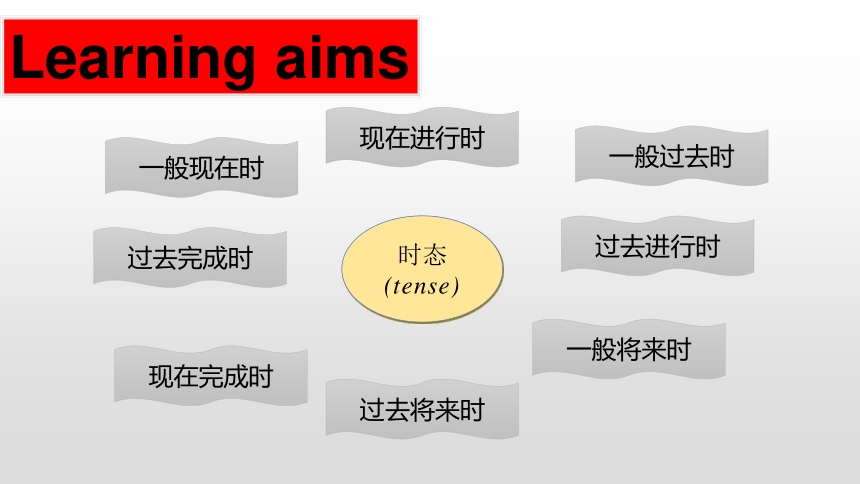

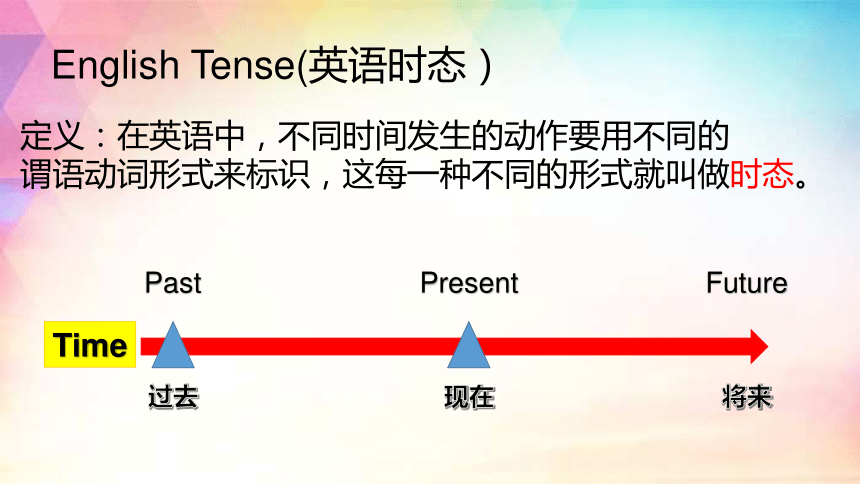
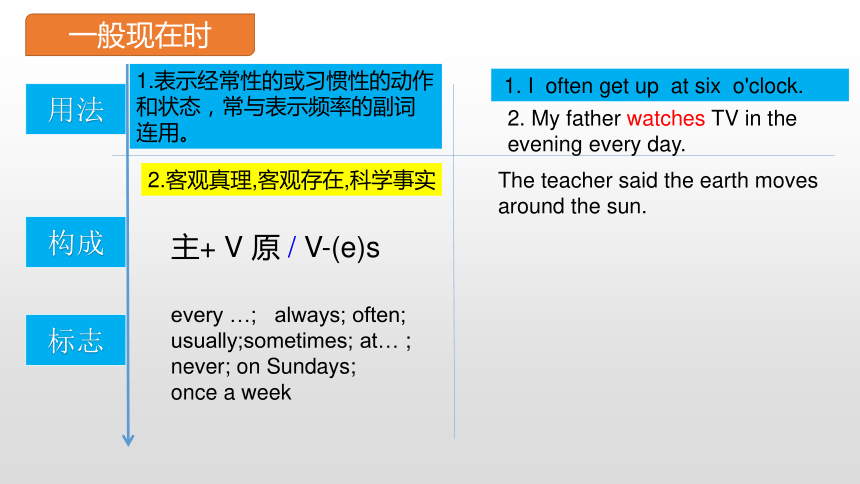
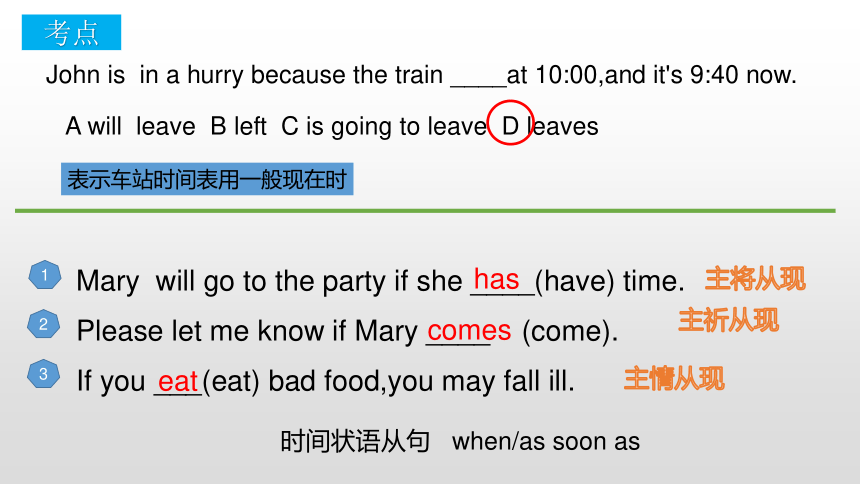
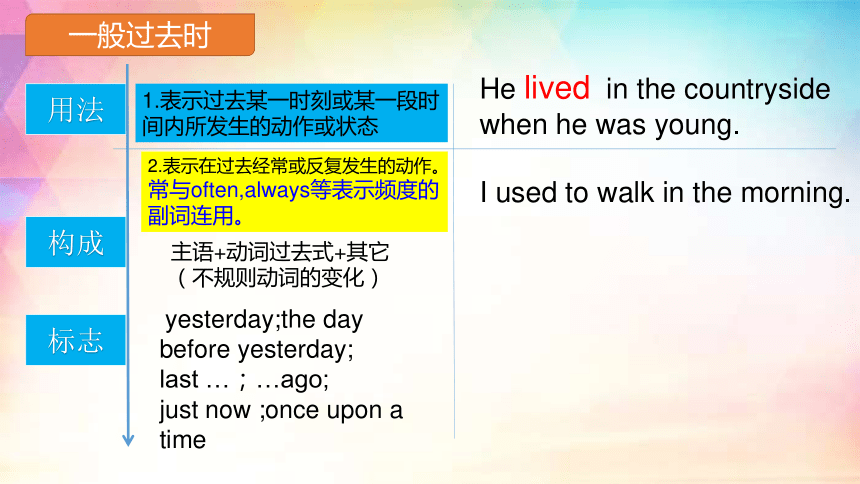
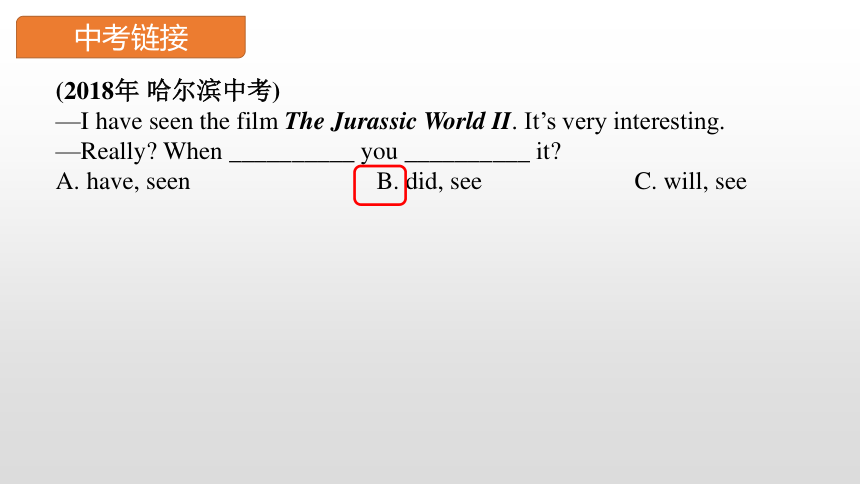
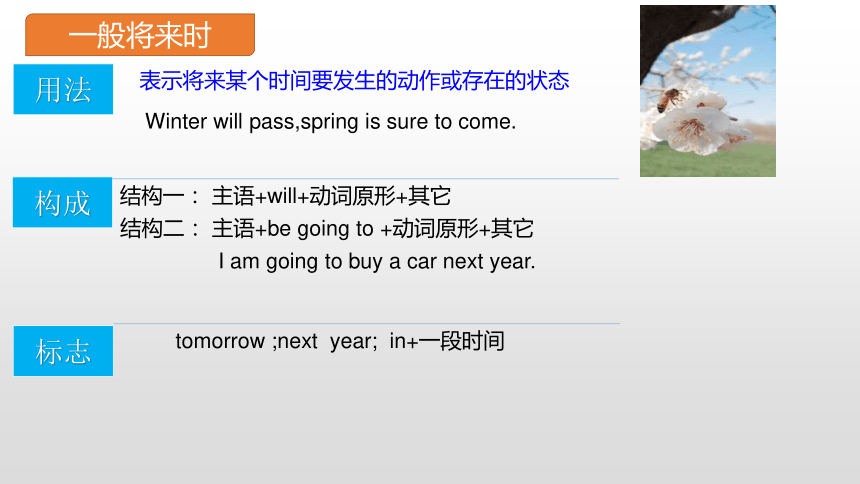
文档简介
(共25张PPT)
专题复习
动
词(二)
时态
(tense)
一般现在时
现在进行时
过去完成时
一般过去时
过去进行时
现在完成时
一般将来时
Learning
aims
过去将来时
句子基本结构:
主
+谓
+(宾)
(动词)
时态
——I
work
in
a
school.
——My
friend
works
in
a
hospital.
——
I
will
work
in
Shanghai
in
the
future.
——She
worked
in
Shanghai
last
year.
——We
have
worked
for
five
years.
——I
am
working
now.
时态在句子中如何体现?
English
Tense(英语时态)
定义:在英语中,不同时间发生的动作要用不同的
谓语动词形式来标识,这每一种不同的形式就叫做时态。
过去
现在
将来
Past
Present
Future
Time
1.表示经常性的或习惯性的动作和状态,常与表示频率的副词连用。
用法
构成
every
…;
always;
often;
usually;sometimes;
at…
;
never;
on
Sundays;
once
a
week
标志
主+
V
原
/
V-(e)s
2.客观真理,客观存在,科学事实
1.
I
often
get
up
at
six
o'clock.
The
teacher
said
the
earth
moves
around
the
sun.
2.
My
father
watches
TV
in
the
evening
every
day.
一般现在时
John
is
in
a
hurry
because
the
train
____at
10:00,and
it's
9:40
now.
A
will
leave
B
left
C
is
going
to
leave
D
leaves
表示车站时间表用一般现在时
考点
主祈从现
主情从现
Mary
will
go
to
the
party
if
she
____(have)
time.
Please
let
me
know
if
Mary
____
(come).
has
comes
If
you
___(eat)
bad
food,you
may
fall
ill.
eat
1
2
3
主将从现
时间状语从句
when/as
soon
as
一般过去时
1.表示过去某一时刻或某一段时间内所发生的动作或状态
用法
构成
yesterday;the
day
before
yesterday;
last
…;…ago;
just
now
;once
upon
a
time
标志
主语+动词过去式+其它
(不规则动词的变化)
2.表示在过去经常或反复发生的动作。常与often,always等表示频度的副词连用。
I
used
to
walk
in
the
morning.
He
lived
in
the
countryside
when
he
was
young.
(2018年
哈尔滨中考)
—I
have
seen
the
film
The
Jurassic
World
II.
It’s
very
interesting.
—Really?
When
__________
you
__________
it?
A.
have,
seen
B.
did,
see
C.
will,
see
中考链接
结构一:
主语+will+动词原形+其它
用法
构成
标志
结构二:
主语+be
going
to
+动词原形+其它
表示将来某个时间要发生的动作或存在的状态
tomorrow
;next
year;
in+一段时间
Winter
will
pass,spring
is
sure
to
come.
一般将来时
I
am
going
to
buy
a
car
next
year.
will
&
be
going
to
区别一:
远期
v.s.
近期
We
will
win
the
war
eventually。
Look
at
the
dark
clouds,
there
is
going
to
be
a
heavy
rain.
考点一
区别二
:
客观
v.s.
主观
区别三:
无迹象
v.s
有迹象
there
will
be或there
is/are
going
to
be…
There
will
be
a
football
match
between
Class
Two
and
Class
One
tomorrow
afternoon.
考点二
(2018年
临沂中考)
The
TV
news
reports
that
there
___________a
storm
the
day
after
tomorrow.
A.
is
B.
was
C.
will
be
D.
has
been
(2018年
乌鲁木齐中考)
There
___________a
folk
music
concert
in
Xinjiang
Opera
Theater
next
month.
A.
is
going
to
have
B.
will
have
C.
is
D.
is
going
to
be
现在进行时
过去进行时
We
are
studying
online
now.
时间:now,at
this
time,at
present
days
语境:Look!
Listen!
Hurry
up
!...
用法
构成
标志
主语+was/were+动词现在分词+其它
表示在过去某时刻正在进行或发生的动作,
通常与表示过去的时间壮语连用。
表示现在(指说话人说话时)
正在发生或进行的动作
主语+am/is/are+动词现在分词+其它
at
that
time;
from
seven
to
nine;
when/while
引导的时间状语从句
I
was
having
an
English
class
at
this
time
yesterday.
when
/while
的区别
(2019
江苏
)
——
Why
are
you
so
late
today?
——
Three
buses
went
by
without
stopping
while
I
_____
at
the
bus
stop.
when
既可指某一点时间,
也可以指一段时间;
while
强调一段时间,
所以从句的谓语动词常是延续性的。
当
when表示“在某一段时间里”
的意思时,
它可以代替
while,
但while不能代替when.
e.g.
When
I
came
home,
she
was
cooking
dinner.
当我到家时,
她正在做饭。
A
am
waiting
B
waited
C
have
waited
D
was
waiting
(2018年
广东中考)
—I
saw
the
light
of
your
room
was
still
on
at
two
o'clock
last
night.
—Oh,
I__________
a
football
match
of
the
Russia
World
Cup.
A.
watches
B.
watch
C.
am
watching
D.
was
watching
(2016济南)Sun
Hai
____
his
mother
make
dinner
when
his
father
got
home
from
work.
A.
was
helping
B
helps
C
helped
D
is
helping
真题
用法
构成
标志
考点
影响性用法:指动作发生在过去且已结束,但对现在产生某种影响。
The
room
is
clean,
because
I
have
cleaned
it.
口诀:动作发生在过去,结果影响到现在
主语
+have
+动词过去分词
+其他
already,
yet,
ever,
never,
just,
for+一段时间,since+(过去时间点或从句
)连用
延续性动词与非延续动词
现在完成时
不规则动词的过去分词需强化记忆。部分动词的过去分词也有规律可循,见下表:
动词变化类型
举例
ABC型
begin—began—begun speak—spoke—spoken
ABB型
find—found—found say—said—said
ABA
型
come—came—come run—ran—run
AAB型
beat—beat—beaten
AAA型
cut—cut—cut cost—cost—cost
短暂性动词和延续性动词
短暂性动词
延续性动词
borrow
buy
arrive/
come
/
go
leave
begin
finish
/
end
join
die
open
????
close
marry
不
与
时
间
段
连
用
可
与
时
间
段
连
用
be
(in)
here
/
there
be
a
member
of
be
dead
be
on
have
be
away
keep
be
over
be
open
(adj.)
be
closed
be
married
1.
—How
long
can
I
____
this
book?
—Two
weeks
A.borrow
B.keep
C.lend
2.
Her
father___in
1990
and
her
husband___for
more
than
five
years.
A.
has
died,
has
died
B.
has
died,
dead
C.
died,
has
been
dead
3.
I
have___
this
nice
watch
for
two
years.
A.
had
B.
bought
C.borrowed
4.
He___his
home
for
ten
years.
A.
has
left
B.
was
away
from
C.has
been
away
from
(2018年
日照中考)
—When
will
you
give
the
novel
back
to
me?
—Sorry,
I
__________
it.
How
about
Friday?
A.
didn’t
finish
B.
won’t
finish
C.
haven’t
finished
D.
don’t
finish
(2019贵州贵阳)Today,
all
the
erhu
masters
play
and
praise
Erquan
Yingyue.
It
_______
one
of
China’s
national
treasures.
A.
becomes
B.
became
C.
has
become
真题
用法
构成
结构一:
主语+would+动词原形+其它
I
would
do
my
homework.
结构二:
主语+was
going
to
+动词原形+其它
主语+were
going
to
+动词原形+其它
表示从过去某时看将要发生的动作或存在的状态。
常用于主句是一般过去时的宾语从句中。
“was/were
going
to+动词原形”所表示的过去将来时,表示过去曾经打算做某事。
He
said
that
he
would
finish
his
work
before
9
o’clock.
过去将来时
用法
构成
标志
表示在过去某一时间或动作以前
已完成的动作或存在的状态(即发生的时间是过去的过去)。
by/before+过去的时间”构成的短语或表过去的时间状语从句
主语+had+动词过去分词+其它
过去完成时
动词填空(共
10
空,计
10
分)(2019
东营改编)
阅读下面短文,用括号内所给动词的适当形式填空
(必要时可加情态动词或助动词)。
One
day
when
Ray
was
flying
his
kite,
he
said
to
himself,
“Did
anybody
ever
try
to
fly
a
kite
at
night?
That
would
be
really
good.
I
(61)
(try)
it
tonight.”
As
soon
as
it
was
dark,
he
(62)
(take)
his
kite
and
lantern,
and
went
to
a
large
field.
He
tied
the
lantern
to
the
tail
of
his
kite.
The
lantern
(63)
(make)
of
paper.
While
Ray
(64)
(enjoy)
his
special
kite,
some
people
in
the
village
also
saw
it.“Look!
A
light(65)
(fly)
in
the
sky,”
one
person
said.
“How
strange!”
said
a
boy.“Let’s
find
out
what
this
strange
light
(66)
(be).”
Then
he
went
to
the
field.
While
this
was
taking
place,
Ray,
who
had
gotten
tired
of
standing,
was
sitting
behind
a
tree.
He
(67)
(see)
the
men
as
they
came,
but
they
didn’t
see
him.
When
they
reached
under
the
light,
and
saw
what
it
was,
they
looked
at
each
other
and
said
while
laughing,
“There
is
nothing
unusual
(68)
(happen)!
This
is
just
a
trick
of
some
naughty
boys’,
but
it
(69)
(fool)
us
all,
let
us
keep
the
secret.”
Ray
thought
it
was
time
for
him
(70)
(go),
so
he
went
home,
too.
will
try
took
was
made
was
enjoying
is
flying
could
see
happening
to
go
has
fooled
is
一看标志;
二定时态;
三写构成。
时态
标志
构成
一般现在时
usually,
often,
sometimes,
every
day
,
every
year,
in
the
morning,
on
Sunday.....
动词原形/
第三人称单数
一般过去时
yesterday,
yesterday
morning...,
last
year,
in
2003
动词的过去式
现在进行时
Listen!
Look!
Be
quiet!
It's
+时刻.
now,
上下文
is/am/are
+
-ing
过去进行时
this
time
yesterday,
at
that
time,
at
2:00
last
Sunday
afternoon....,
上下文...
was/were
+
-ing
一般将来时
tomorrow,
tomorrow
morning/....,
next
week/....,
in
two
days....,
in
2050....
will
+动词原形
be
going
to
+动词原形
现在完成时
already,
just,
yet,
ever....,
so
far,
for
+一段时间,
since
+时间点,
上下文...
have/
has
+
过去分词
Summary
Homework
Review
the
tenses
and
finish
the
exercises.
专题复习
动
词(二)
时态
(tense)
一般现在时
现在进行时
过去完成时
一般过去时
过去进行时
现在完成时
一般将来时
Learning
aims
过去将来时
句子基本结构:
主
+谓
+(宾)
(动词)
时态
——I
work
in
a
school.
——My
friend
works
in
a
hospital.
——
I
will
work
in
Shanghai
in
the
future.
——She
worked
in
Shanghai
last
year.
——We
have
worked
for
five
years.
——I
am
working
now.
时态在句子中如何体现?
English
Tense(英语时态)
定义:在英语中,不同时间发生的动作要用不同的
谓语动词形式来标识,这每一种不同的形式就叫做时态。
过去
现在
将来
Past
Present
Future
Time
1.表示经常性的或习惯性的动作和状态,常与表示频率的副词连用。
用法
构成
every
…;
always;
often;
usually;sometimes;
at…
;
never;
on
Sundays;
once
a
week
标志
主+
V
原
/
V-(e)s
2.客观真理,客观存在,科学事实
1.
I
often
get
up
at
six
o'clock.
The
teacher
said
the
earth
moves
around
the
sun.
2.
My
father
watches
TV
in
the
evening
every
day.
一般现在时
John
is
in
a
hurry
because
the
train
____at
10:00,and
it's
9:40
now.
A
will
leave
B
left
C
is
going
to
leave
D
leaves
表示车站时间表用一般现在时
考点
主祈从现
主情从现
Mary
will
go
to
the
party
if
she
____(have)
time.
Please
let
me
know
if
Mary
____
(come).
has
comes
If
you
___(eat)
bad
food,you
may
fall
ill.
eat
1
2
3
主将从现
时间状语从句
when/as
soon
as
一般过去时
1.表示过去某一时刻或某一段时间内所发生的动作或状态
用法
构成
yesterday;the
day
before
yesterday;
last
…;…ago;
just
now
;once
upon
a
time
标志
主语+动词过去式+其它
(不规则动词的变化)
2.表示在过去经常或反复发生的动作。常与often,always等表示频度的副词连用。
I
used
to
walk
in
the
morning.
He
lived
in
the
countryside
when
he
was
young.
(2018年
哈尔滨中考)
—I
have
seen
the
film
The
Jurassic
World
II.
It’s
very
interesting.
—Really?
When
__________
you
__________
it?
A.
have,
seen
B.
did,
see
C.
will,
see
中考链接
结构一:
主语+will+动词原形+其它
用法
构成
标志
结构二:
主语+be
going
to
+动词原形+其它
表示将来某个时间要发生的动作或存在的状态
tomorrow
;next
year;
in+一段时间
Winter
will
pass,spring
is
sure
to
come.
一般将来时
I
am
going
to
buy
a
car
next
year.
will
&
be
going
to
区别一:
远期
v.s.
近期
We
will
win
the
war
eventually。
Look
at
the
dark
clouds,
there
is
going
to
be
a
heavy
rain.
考点一
区别二
:
客观
v.s.
主观
区别三:
无迹象
v.s
有迹象
there
will
be或there
is/are
going
to
be…
There
will
be
a
football
match
between
Class
Two
and
Class
One
tomorrow
afternoon.
考点二
(2018年
临沂中考)
The
TV
news
reports
that
there
___________a
storm
the
day
after
tomorrow.
A.
is
B.
was
C.
will
be
D.
has
been
(2018年
乌鲁木齐中考)
There
___________a
folk
music
concert
in
Xinjiang
Opera
Theater
next
month.
A.
is
going
to
have
B.
will
have
C.
is
D.
is
going
to
be
现在进行时
过去进行时
We
are
studying
online
now.
时间:now,at
this
time,at
present
days
语境:Look!
Listen!
Hurry
up
!...
用法
构成
标志
主语+was/were+动词现在分词+其它
表示在过去某时刻正在进行或发生的动作,
通常与表示过去的时间壮语连用。
表示现在(指说话人说话时)
正在发生或进行的动作
主语+am/is/are+动词现在分词+其它
at
that
time;
from
seven
to
nine;
when/while
引导的时间状语从句
I
was
having
an
English
class
at
this
time
yesterday.
when
/while
的区别
(2019
江苏
)
——
Why
are
you
so
late
today?
——
Three
buses
went
by
without
stopping
while
I
_____
at
the
bus
stop.
when
既可指某一点时间,
也可以指一段时间;
while
强调一段时间,
所以从句的谓语动词常是延续性的。
当
when表示“在某一段时间里”
的意思时,
它可以代替
while,
但while不能代替when.
e.g.
When
I
came
home,
she
was
cooking
dinner.
当我到家时,
她正在做饭。
A
am
waiting
B
waited
C
have
waited
D
was
waiting
(2018年
广东中考)
—I
saw
the
light
of
your
room
was
still
on
at
two
o'clock
last
night.
—Oh,
I__________
a
football
match
of
the
Russia
World
Cup.
A.
watches
B.
watch
C.
am
watching
D.
was
watching
(2016济南)Sun
Hai
____
his
mother
make
dinner
when
his
father
got
home
from
work.
A.
was
helping
B
helps
C
helped
D
is
helping
真题
用法
构成
标志
考点
影响性用法:指动作发生在过去且已结束,但对现在产生某种影响。
The
room
is
clean,
because
I
have
cleaned
it.
口诀:动作发生在过去,结果影响到现在
主语
+have
+动词过去分词
+其他
already,
yet,
ever,
never,
just,
for+一段时间,since+(过去时间点或从句
)连用
延续性动词与非延续动词
现在完成时
不规则动词的过去分词需强化记忆。部分动词的过去分词也有规律可循,见下表:
动词变化类型
举例
ABC型
begin—began—begun speak—spoke—spoken
ABB型
find—found—found say—said—said
ABA
型
come—came—come run—ran—run
AAB型
beat—beat—beaten
AAA型
cut—cut—cut cost—cost—cost
短暂性动词和延续性动词
短暂性动词
延续性动词
borrow
buy
arrive/
come
/
go
leave
begin
finish
/
end
join
die
open
????
close
marry
不
与
时
间
段
连
用
可
与
时
间
段
连
用
be
(in)
here
/
there
be
a
member
of
be
dead
be
on
have
be
away
keep
be
over
be
open
(adj.)
be
closed
be
married
1.
—How
long
can
I
____
this
book?
—Two
weeks
A.borrow
B.keep
C.lend
2.
Her
father___in
1990
and
her
husband___for
more
than
five
years.
A.
has
died,
has
died
B.
has
died,
dead
C.
died,
has
been
dead
3.
I
have___
this
nice
watch
for
two
years.
A.
had
B.
bought
C.borrowed
4.
He___his
home
for
ten
years.
A.
has
left
B.
was
away
from
C.has
been
away
from
(2018年
日照中考)
—When
will
you
give
the
novel
back
to
me?
—Sorry,
I
__________
it.
How
about
Friday?
A.
didn’t
finish
B.
won’t
finish
C.
haven’t
finished
D.
don’t
finish
(2019贵州贵阳)Today,
all
the
erhu
masters
play
and
praise
Erquan
Yingyue.
It
_______
one
of
China’s
national
treasures.
A.
becomes
B.
became
C.
has
become
真题
用法
构成
结构一:
主语+would+动词原形+其它
I
would
do
my
homework.
结构二:
主语+was
going
to
+动词原形+其它
主语+were
going
to
+动词原形+其它
表示从过去某时看将要发生的动作或存在的状态。
常用于主句是一般过去时的宾语从句中。
“was/were
going
to+动词原形”所表示的过去将来时,表示过去曾经打算做某事。
He
said
that
he
would
finish
his
work
before
9
o’clock.
过去将来时
用法
构成
标志
表示在过去某一时间或动作以前
已完成的动作或存在的状态(即发生的时间是过去的过去)。
by/before+过去的时间”构成的短语或表过去的时间状语从句
主语+had+动词过去分词+其它
过去完成时
动词填空(共
10
空,计
10
分)(2019
东营改编)
阅读下面短文,用括号内所给动词的适当形式填空
(必要时可加情态动词或助动词)。
One
day
when
Ray
was
flying
his
kite,
he
said
to
himself,
“Did
anybody
ever
try
to
fly
a
kite
at
night?
That
would
be
really
good.
I
(61)
(try)
it
tonight.”
As
soon
as
it
was
dark,
he
(62)
(take)
his
kite
and
lantern,
and
went
to
a
large
field.
He
tied
the
lantern
to
the
tail
of
his
kite.
The
lantern
(63)
(make)
of
paper.
While
Ray
(64)
(enjoy)
his
special
kite,
some
people
in
the
village
also
saw
it.“Look!
A
light(65)
(fly)
in
the
sky,”
one
person
said.
“How
strange!”
said
a
boy.“Let’s
find
out
what
this
strange
light
(66)
(be).”
Then
he
went
to
the
field.
While
this
was
taking
place,
Ray,
who
had
gotten
tired
of
standing,
was
sitting
behind
a
tree.
He
(67)
(see)
the
men
as
they
came,
but
they
didn’t
see
him.
When
they
reached
under
the
light,
and
saw
what
it
was,
they
looked
at
each
other
and
said
while
laughing,
“There
is
nothing
unusual
(68)
(happen)!
This
is
just
a
trick
of
some
naughty
boys’,
but
it
(69)
(fool)
us
all,
let
us
keep
the
secret.”
Ray
thought
it
was
time
for
him
(70)
(go),
so
he
went
home,
too.
will
try
took
was
made
was
enjoying
is
flying
could
see
happening
to
go
has
fooled
is
一看标志;
二定时态;
三写构成。
时态
标志
构成
一般现在时
usually,
often,
sometimes,
every
day
,
every
year,
in
the
morning,
on
Sunday.....
动词原形/
第三人称单数
一般过去时
yesterday,
yesterday
morning...,
last
year,
in
2003
动词的过去式
现在进行时
Listen!
Look!
Be
quiet!
It's
+时刻.
now,
上下文
is/am/are
+
-ing
过去进行时
this
time
yesterday,
at
that
time,
at
2:00
last
Sunday
afternoon....,
上下文...
was/were
+
-ing
一般将来时
tomorrow,
tomorrow
morning/....,
next
week/....,
in
two
days....,
in
2050....
will
+动词原形
be
going
to
+动词原形
现在完成时
already,
just,
yet,
ever....,
so
far,
for
+一段时间,
since
+时间点,
上下文...
have/
has
+
过去分词
Summary
Homework
Review
the
tenses
and
finish
the
exercises.
同课章节目录
- 词法
- 名词
- 动词和动词短语
- 动词语态
- 动词时态
- 助动词和情态动词
- 非谓语动词
- 冠词
- 代词
- 数词和量词
- 形容词副词及其比较等级
- 介词和介词短语
- 连词和感叹词
- 构词法
- 相似、相近词比较
- 句法
- 陈述句
- 一般疑问句和否定疑问句
- 特殊疑问句及选择疑问句
- 反意疑问句
- 存在句(There be句型)
- 宾语从句
- 定语从句
- 状语从句
- 主谓一致问题
- 简单句
- 并列句
- 复合句
- 主谓一致
- 主、表语从句
- 名词性从句
- 直接引语和间接引语
- 虚拟语气
- 感叹句
- 强调句
- 倒装句
- 祈使句
- 句子的成分
- 句子的分类
- 题型专区
- 单项选择部分
- 易错题
- 完形填空
- 阅读理解
- 词汇练习
- 听说训练
- 句型转换
- 补全对话
- 短文改错
- 翻译
- 书面表达
- 任务型阅读
- 语法填空
- 其他资料
